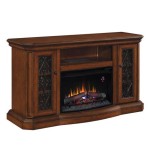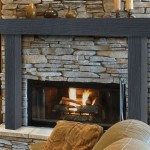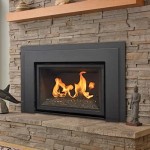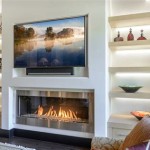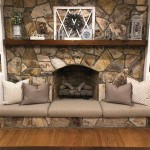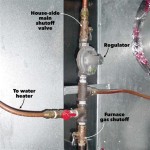Designing a Modern Living Room with a TV and Fireplace
The confluence of entertainment and warmth in a living room often centers around two focal points: the television and the fireplace. Integrating these elements harmoniously within a modern aesthetic requires careful consideration of spatial arrangement, material selection, and technological integration. A well-designed living room that incorporates both a TV and a fireplace can create a comfortable and visually appealing gathering space.
Modern design principles emphasize clean lines, minimal ornamentation, and functional layouts. This approach translates into a living room that feels spacious, uncluttered, and promotes relaxation. Achieving this balance with both a TV and a fireplace requires a strategic design plan. The placement of these features, the style of their surrounding structures, and the integration of complementary furniture all contribute to the overall success of the space.
Prioritizing Spatial Arrangement
The first step in designing a modern living room with a TV and fireplace is to determine the optimal spatial arrangement. Given that both elements are often visually dominant, their placement relative to each other and to the seating area is crucial. Several arrangements are commonly employed, each with its own set of advantages and disadvantages. Exploring these layouts before committing to a particular design is essential.
One approach is to position the TV and fireplace on the same wall. This configuration creates a single focal point, drawing the eye to one area of the room. To prevent visual overload, consider offsetting the TV and fireplace slightly. For example, the fireplace could be positioned closer to one corner of the wall, with the TV placed towards the center. This asymmetry makes the wall more dynamic and less monotonous. Furthermore, consider the height of both elements. If the TV is mounted above the fireplace, ensure that the viewing angle is comfortable and ergonomic. Placing the TV too high can lead to neck strain during extended viewing periods.
An alternative arrangement involves placing the TV and fireplace on adjacent walls. This layout creates two distinct focal points, which can help to define different zones within the living room. For instance, the fireplace area could be designated as a cozy reading nook, while the TV area serves as the primary entertainment zone. This separation requires careful consideration of furniture placement to ensure that the seating area accommodates both focal points effectively. A sectional sofa, for example, can be positioned to provide comfortable viewing angles for both the TV and the fireplace.
A third option, often implemented in larger living rooms, is to position the TV and fireplace on opposite walls. This configuration creates a more balanced and symmetrical layout. However, it also requires significant space to prevent the room from feeling cramped or overcrowded. If employing this arrangement, ensure that the distance between the TV and seating area is sufficient to provide an optimal viewing experience. Similarly, the distance between the fireplace and seating area should be adequate to prevent overheating or discomfort.
Beyond the placement of the TV and fireplace, consider the location of windows and doorways. Natural light is a valuable asset in any living room, but excessive glare can interfere with TV viewing. Position the TV in a location where it is not directly exposed to sunlight. Consider using window treatments, such as blinds or curtains, to control the amount of light entering the room. Similarly, avoid placing the fireplace near doorways or areas with high foot traffic, as this can create a safety hazard.
Selecting Materials and Finishes
The materials and finishes used in the construction and surrounding of the TV and fireplace significantly impact the overall aesthetic of the modern living room. Opting for materials that complement each other and align with the overall design style is crucial. Modern design often favors natural materials, such as wood, stone, and metal, in their raw or minimally processed state.
For the fireplace surround, consider using materials such as concrete, brick, or natural stone. Concrete provides a sleek and minimalist look, while brick offers a more rustic and textured appearance. Natural stone can add a touch of elegance and sophistication to the fireplace area. The choice of material should be guided by the overall design style of the room and the desired level of formality.
The wall behind the TV can be treated in various ways to enhance its visual impact. One option is to create an accent wall using a different color or texture than the other walls in the room. This can help to visually separate the TV area from the rest of the living room and draw attention to it. Another option is to use a textured wallpaper or wall paneling to add depth and interest to the wall. Avoiding overly busy or distracting patterns is recommended, as this can detract from the viewing experience.
When selecting materials for furniture and accessories, prioritize those that complement the overall design scheme. Leather sofas, wooden coffee tables, and metal accent pieces are all common choices in modern living rooms. Consider the color palette of the room when selecting materials. A neutral color palette, such as grays, whites, and beiges, provides a versatile backdrop for incorporating pops of color through accessories and artwork.
In terms of flooring, hardwood, tile, or concrete are all suitable choices for a modern living room. Hardwood provides a warm and inviting feel, while tile and concrete offer a more contemporary and minimalist look. Consider using area rugs to define different zones within the living room and add warmth and texture to the space.
Integrating Technology Seamlessly
In a modern living room, the integration of technology should be seamless and unobtrusive. The TV and fireplace should be incorporated into the design in a way that minimizes their visual impact and maximizes their functionality. This requires careful planning and attention to detail, particularly when it comes to concealing wires and cables.
One common approach to concealing TV wires is to run them through the wall. This requires opening up the wall cavity and installing conduit to protect the wires. The wires can then be run from the TV to a media console or cabinet located below the TV. This method provides a clean and clutter-free look. Alternatively, a wire management system can be used to bundle and conceal the wires behind the TV. These systems typically consist of plastic channels or sleeves that attach to the wall and hide the wires from view.
For the fireplace, consider using a remote-controlled gas fireplace or an electric fireplace. These options eliminate the need for wood storage and reduce the amount of mess associated with traditional fireplaces. Remote-controlled fireplaces also offer greater convenience and control over the flame intensity and heat output. Furthermore, electric fireplaces can be easily installed in any room, without the need for venting or gas lines.
When selecting a TV, consider the size and resolution of the screen. A larger screen typically provides a more immersive viewing experience, but it is important to ensure that the TV is not too large for the space. A general rule of thumb is to multiply the screen size by 1.5 to determine the optimal viewing distance. For example, a 55-inch TV should be viewed from approximately 82.5 inches (6.9 feet) away.
Incorporate smart home technology into the living room to enhance its functionality and convenience. Smart lighting, smart thermostats, and smart sound systems can all be controlled remotely using a smartphone or voice assistant. This allows for customized control over the ambiance and environment of the living room.
Sound systems require careful consideration in a modern living room. While surround sound systems can offer an immersive audio experience, they can also create a cluttered and visually distracting environment. Consider using a soundbar or wireless speaker system to minimize the number of wires and speakers in the room. These systems can provide high-quality audio without compromising the aesthetic of the living room.
Furniture placement plays a crucial role in maximizing the functionality and aesthetics of the modern living room. Select furniture that complements the overall design style and provides comfortable seating and storage options. Consider using multi-functional furniture, such as ottomans with built-in storage or coffee tables that can be converted into dining tables.
Lighting is another important consideration in a modern living room. Use a combination of ambient, task, and accent lighting to create a warm and inviting atmosphere. Ambient lighting provides overall illumination, while task lighting is used for specific activities, such as reading or working. Accent lighting is used to highlight architectural features or artwork. Dimmable lighting allows for customized control over the brightness and intensity of the light, creating a more comfortable and adaptable environment.

13 Impressive Living Room Ideas With Fireplace And Tv Lmolnar Designs Design

Family Room Ideas Contemporary Living Design Modern Rooms

13 Impressive Living Room Ideas With Fireplace And Tv Lmolnar Contemporary Design Family House

3 Tips For Installing A Tv Over Your Fireplace

Modern Tv Wall With Fireplace Iv Yo Carpentry

Tv And Fireplace In One Room Find The Perfectly Happy Spot For That Black Beast Form Design Tasteful Interiors Living Well

7 Ways To Rock A Tv And Fireplace Combo

35 Best Living Room Ideas With Fireplace And Tv Photos For 2024 Wall Trendy Rooms

A Modern Living Room Remodel In Manhattan Warms Up

7 Ways To Rock A Tv And Fireplace Combo
Related Posts

